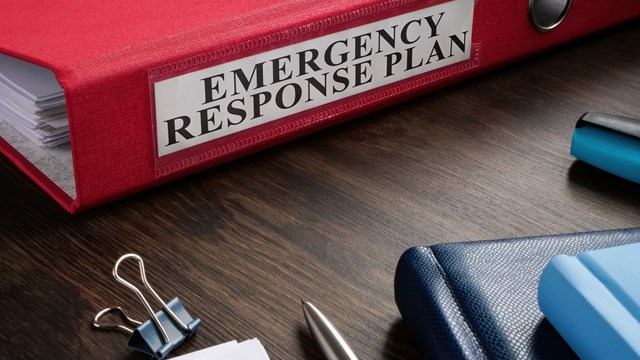
While the Boston Marathon bombing of April 2013 stands as the biggest catastrophe to befall the New England area in recent years, residents must be on guard for many potential disasters, be they fires, nor'easters, floods or building collapses. To brace a condominium association for these and many other possible calamities, it’s critical to have an updated emergency plan in place that reflects the uniqueness of the building and property. The end goal in any emergency event is a clearly defined, safe plan for evacuation and recovery.
Know Thy Enemy
While major storms can and do occur, there are myriad other concerns for which an association must be aware and prepared. As Candice Morse, a property manager with Thayer & Associates in Cambridge, Massachusetts, notes, frozen sprinkler lines, oil leaks from underground storage tanks, hot water tank or chiller failures, roof collapses and tidal events in coastal properties can all have damaging effects to a property.
Charles A. Perkins, a senior partner with the law firm of Perkins & Anctil, P.C. in Westford, Massachusetts, adds even further to this list. “Especially when you’re dealing with high-rises, you can have hot water heaters popping, and all of a sudden water is running down all the way through the buildings; you can have construction defects or roof leaks that cause mold; you can have machines or dishwashers with old hoses that break. While not as significant as a Category 5 storm, these occurrences are significant enough to cause major financial problems within the building.”
And disasters aren’t uniform throughout the area. “Even in Massachusetts, the emergencies that you’re going to have on the coast differ from the emergencies that you’re going to have up in Worcester or someplace else,” continues Perkins.
Despite the cornucopia of strike-able disasters, the majority will involve water, so it’s best to be prepared for leaks and floods. “Water is indeed the most prevalent cause of damage nationwide,” confirms David Abel, CMCA, a senior property manager for First Realty Management Corp. in Boston.
First Things First
While there aren’t specific legal guidelines in place that govern what an association’s disaster plan must entail, the general consensus—and most, if not all, association by-laws — indicate that it’s an essential part of condominium management. And, while seemingly obvious, it cannot be overstated that the first, most imperative step to take in the wake of any disaster is to ensure the well-being of residents.
“Preserving the lives of residents and ensuring that safety systems are functional is paramount in any emergency,” says Abel. “From there, attacking water damage is probably the second priority, in regard to physical considerations. Finally, from a personnel standpoint, clear communication and guidance to residents should be the main concern.”
The best way to ensure that these crucial first steps are performed without a hitch is to iron them out beforehand, and make sure to practice. Morse recommends that an association “ensure that each staff member has a clear and written job responsibility in its emergency plan. Staff should participate in an annual mock evacuation drill to ensure that they, as well as residents, are clear on the steps to follow. Boards can use various means of communication, including phone blasts, email blasts and the building’s internal fire safety system alerts” to guarantee that everyone is notified the second a disaster strikes.
Because help isn’t going to intuit when an emergency is at hand, Perkins advocates having the essential phone numbers centrally located and accessible to both board and residents at a moment's notice. Outside of the obvious fire/police/ambulance hotlines, Perkins recommends including numbers for the Red Cross, Salvation Army, nearby hotels, and anything else that could come in handy in event of an evacuation.
Perkins continues to illustrate the weight that falls upon the shoulders of a management company in these extreme situations. “Let’s take the standard example of a water-related situation developing within an association. The board should have an emergency number for its management company at the ready. Then, management must in turn have ready access to its preferred list of vendors who will handle any remediation work. Management must also have insurance on the line immediately. If the problem is immense enough, management must be able to contact their chosen public adjuster.”
These things must happen like clockwork if an emergency is going to be effectively resolved without harming residents or damaging property beyond repair.
Making the Plan
For a new association looking to develop an emergency plan of its own, there may be some trepidation as to where one should begin. Fortunately, there are ample resources available to which an association can look for guidance.
As Perkins points out, the Community Associations Institute (CAI), for one, has a particularly thorough website dedicated to both preparing for and rebuilding after a disaster. “If an association needs a helping hand, there are plenty of templates available that one can follow,” he says. And FEMA offers additional information to brace a community for even the worst of circumstances.
Another primary concern for an association when considering a plan is cost, in regard to both time and money. How long will it take to devise a reliable and thorough strategy? How much will it cost to undergo a safe and successful evacuation? How responsible will the association and owners be for property damage?
By utilizing the resources mentioned above and doing some research, ample time can be saved, and, as Morse explains, “associations can control the cost of preparing an emergency disaster plan by working closely with first responders to draft an evacuation strategy. IREM (the Institute of Real Estate Management) has great resources available to begin the process as well. Generally, natural disasters and other building calamities are considered covered losses. Associations should also reach out to their insurance companies on an annual basis to ensure that their properties are adequately covered and that the building policy limits are sufficient to cover a total loss.”
Assuming that an association does its due diligence, the knowledge that a major disaster at its property is typically an expense covered by its master insurance program, as Morse points out, should help take some pressure off an already intense situation. A condominium’s governing documents should lay out a board’s role and responsibility in managing losses from day one, leaving little question as to how the aftermath of a disaster will play out, financially.
Sharing is Caring
As Abel makes clear, a “key component [in disaster preparation] is to ensure that all staff has instant access to data, i.e. owners’ and vendors’ contact information, and to be able to communicate quickly and efficiently to owners and residents.” But leaving the aforementioned owners and residents to their own devices until a major crisis is at hand would be a fool’s errand. In order to most effectively prepare for a disaster, education is essential.
“In my opinion, the best way to educate residents about emergency response plans is to hold a special meeting to demonstrate to them, step by step, the procedures that they should follow when dealing with a building evacuation, and to have a written plan that is readily available,” says Morse. “Clear signage should be posted in prominent areas throughout the property as well.”
And Perkins advocates having a book handy that includes every agreed-upon step in event of disaster, with emergency numbers and contact information for the management company -- especially if you’re in a high-rise, wherein even smaller disasters can have a profound impact.
Not everything included in a disaster plan should be reactive, either. As Morse puts it, “residents must be educated on prevention measures that would help avoid something—other than a natural disaster—in a building, as in a fire or a flood. The local police and fire departments are available to assist in preparation of emergency plans, as well as to assist with mock evacuation drills.”
To give but one example of this, Perkins cites an association that he’s worked with on the ocean. “They know that, in the event of a nor’easter, if they don’t get down to the shore before high tide and sandbag the area, they’re going to lose things in the garage, and the elevators will flood. So they have a whole protocol for this one specific circumstance. They know who needs to be out there, with whom responsibilities lie, and they know to be ready for this scenario.”
And it’s not just the association and management that need to be educated; first responders’ jobs are made greatly easier when they’re not flying blind. This is especially true when dealing with elderly residents, pets, or anyone who may have difficulty evacuating on their own, should the situation call for it.
“We typically ensure that the building staff has emergency contact information for the “elderly residents,: says Morse. “We have the appropriate signage in the vestibule areas for first responders that indicate which units will require special assistance in a disaster, or in an emergency evacuation of the building.”
That Most Precious of Gifts
While it’s always saddening to have property destroyed or damaged, at the end of the day, possessions are most likely insured, can be replaced, and matter little when compared to the human lives at stake.
“Life safety should be the top priority when evacuating a building,” Morse states plainly. “The staff should be focused on managing the evacuation and following the instructions provided by the first responders.”
That latter part is especially important. While an association can, in fact, plan for a rainy day, as Perkins notes, there will always be some unforeseen variable in any disaster situation that no one could envision. By contacting the fire department, the police, EMTs—whatever care that is necessary—in a timely fashion, an association is putting its fortunes in the hands of highly trained and very capable professionals who can lead everyone to safety, granted those in harm’s way listen and remain responsive.
“We encountered a situation where a condominium of 44 units burned entirely to the ground,” says Perkins. But, because a disaster plan was in place and the appropriate experts were contacted in a timely fashion, “everyone got out alright. There was a library around the corner with a gymnasium that was co-opted as the central location for info throughout the entire ordeal. In this type of situation, things can happen on the fly that weren’t written down in any disaster plan beforehand. But these improvisations thereby become the new plan from then on out.”
Through research, open communication, and the identification of capable, reliable and trained third party agencies, an association can create a plan that puts the life and well-being of its residents first in the wake of any disaster, providing a great relief to everyone, from management to board to residents.
Michael Odenthal is a staff writer for New England Condominium and other publications.






Leave a Comment